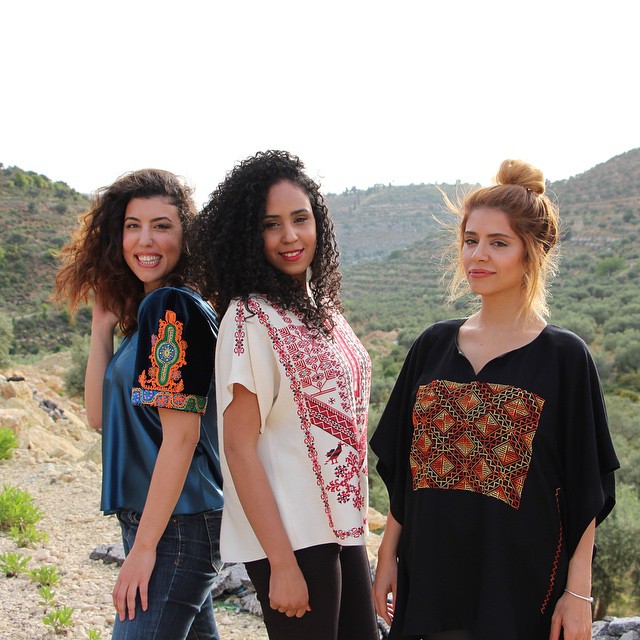“Every one of us has a grandmother who makes clothes, knitting sweaters or embroidery for her whole family. But when your grandmother comes from Palestine, embroidery takes on a whole other meaning.”
Traditional Palestinian folk arts have a long rich and deep rooted history as a form of art and language of expression documenting the history, culture and everyday life of the people of Palestine for centuries.
Tatreez, or embroidery, however, have become an important symbol of Palestinian history and heritage, weaving together intricate patterns that traditionally represent a village, family or way of life.
Social enterprise Taita Leila aims to employ Palestinian women while restyling and reviving traditional embroidery and showcase the stories behind the embroidery. Producing modern clothing inspired by traditional Palestinian dress, this creative project repurposes the beloved handicraft of embroidery in a way “that your grandmother would be proud to wear it.”
“Palestinian embroidery is so important to Palestinians, but its significance is not understood in places other than the Middle East,” said a member of the Taita Leila team. “It was so nuanced, a language, that we wanted to show this side of our culture.”
The Taita (the Arabic term of endearment for grandmother) after which the project is named is Leila Hussein Fakhri Kalidi, author of the book “The Art of Palestinian Embroidery.” After leaving Jerusalem in 1946, she became head librarian at the PLO Research Centre in Beirut from 1971 to 1978 and founded the Palestinian Martyrs’ Works Society’s Central Library and head a research unit for Folklore and Folk Arts and Crafts. In 1981, the PLO Research Centre Library was recognized as the national library of the Palestinian people and in 1986, a folk museum was established within SAMED.
According to the social enterprise’s website, Taita Leila aims to do two things – Bring out the stories behind the embroidery by decoding, repackaging and reworking the traditional Palestinian language of thread, and secondly, employ women who know how to embroider and making these designs wearable to incorporate them into a modern wardrobe.
“Granny chic is making a comeback,” said the member of Taita Leila’s team.
As a particularly powerful way of empowering women through traditions, culture and heritage, this endeavor is turning embroidery into an economic opportunity that provides Palestinian women with the means to become financially independent as well as celebrate an unsung talent.
At the same time, Taita Leila re-imagines traditional Palestinian embroidery to appeal to younger generations around the globe.
Etching stories on cloth
More than just a form of employment, the social enterprise also discovers, collects and showcases unique embroidery designs from around Palestine, each a story threaded on cloth. Using Palestinian motifs and symbols to tell the stories of the women behind the embroidery, these unique patterns draw from historical events and stories.
The stories for Taita’s Leila’s collection are collated from a variety of sources, including The Art of Palestinian Embroidery as well as other books, exhibitions and people.
Depending on one’s status, line of work and hometown, Palestinian embroidery includes a wide range of traditional styles of stitching, patterns and colors.
“By adopting the traditional styles and motifs of her area, a woman expressed her wish to identify and be identified with her cultural roots,” Taita Leila wrote in ‘The Art of Palestinian Embroidery.’
The qabbeh for example, is a classic style of sewing chest panels on a loose thoub or dress in Ramallah which is said to have Hellenic influences, representing the flora and fauna of the mountainous region. The tahriri or risheq stitch – most famous in Bethlehem – is couching with silver, gold, and silk cord, inspired by ornate Church ornaments and clothing. It is commonly used for the front panels of wedding dresses, the side panels of skirts or the cuffs of long dresses.
“The stories are woven into the designs as a background to explain why they look the way they do- Bethlehem was influenced by the Church, Jerusalem by the Ottomans mostly, Yaffa by the famous oranges,” said Taita Leila’s team member. “Instead of observing the costumes in a museum, we wanted to make something you would incorporate into your everyday life, to bring it back home.”
The social enterprise has launched a crowdfunding campaign on AFKARMENA to get the business up and running.
While celebrating another side of Palestinian culture that people around the world probably know little about, this venture is empowering women and showcasing a nuanced, relatable art that deserves to revived, repurposed and worn with pride as they did – one beautiful piece at a time.




















Sounds interesting. On one hand, these designs could look really cool if made modern. On the other, the business needs to upscale its marketing and outreach and all.
Hope it does, to be honest. I would buy it haha..
Great idea! Why should people forget the traditions of our people and ancestors when we can bring them back into the 21st century.
beautiful!